
painting - 'Meditation'
Dr Jonathan Hare - period of award: 2000 - 2004
click here to jump ahead for information on (use 'back' button to come back to top of page):
List of Publications
Prototypes and inventions
Each year at a glance
Meditation
Comments on JPH's NESTA artwork
This is the final report of my fellowship which covered 4 wonderful years. Most of my work has been described in detail in the yearly reports I have submitted over the fellowship. I concentrate here on bringing the results together to give an overview. I have also added here an 'outline of meditation' in the appendix to clarify this area of the fellowship.
Initial aims and objectives as described in the original application form
(Brief Description of Proposal - submitted 2000)
NESTA funding would be used to support a number of key activities that will develop, broaden and enhance my ability to be creative and innovative. These have also been chosen to deepen my understanding of my own motivations and aspirations as well as contribute to my ability to interact with other people. This will be directly useful, for example, in my educational work within the community through the Creative Science Centre (CSC Sussex University). NESTA will support three strands of development: 1) creative thinking 2) meditation and 3) creative days.
Meeting these objectives over the fellowship
My NESTA fellowship was a part time venture, 1 day a week for 4 years. Although this amounts to less than a total of a year of time it is interesting how much material has been covered. “1 day a week” can be productive.
I wanted to use NESTA fellowship time to explore new areas, try out ideas, to experiment with new technologies and generally 'sow seeds' for the future. I think that I have been successful in this. Through the NESTA support I have maintained an on-going adventure – designing, making, turning day dreams into real things, sketching, painting and exploring meditation.
A difficult area of the fellowship to assess is the time spent exploring meditation. To help I have included here an 'outline to meditation' this appears in Appendix 1. A summary list of the main inventions and prototypes are given in Appendix II and a list of publications and press articles is given in appendix III. Appendix IV presents comments on my art work from other artists. Appendix V details the financial aspects of the fellowship.
Reports, pictures, diagrams and a portfolio of NESTA fellowship work can be seen on my web site: http://www.creative-science.org.uk/nesta2.html
Summary of appendix contents
Appendix I - An outline of meditation
Appendix II - Fellowship activities and a glance at each year
Appendix III - Articles and published papers
Appendix IV - Reviews of JPH's fellowship art work by other artists
Reflections on the Fellowship
Something that has become apparent during the course of the fellowship is just how motivated I am at pursuing 'simple solutions' to problems. I have realised that my most satisfying work has been when I have taken a complex problem and reduced it as far as I could go. The end result may look deceptively simple even if it took quite an effort to get to this stage. There is usually some fundamental understanding that can be discovered by reducing an idea to its bare essentials. This is also a very powerful way of teaching. Although it was not an original aim I have been able to publish quite a lot of my fellowship work so that it has reached a larger audience. This has lead to a wealth of e-mail contacts from inventors as well as from teachers for example.
I think the meditation practice fits in with the striving for a simple solution. Letting thoughts 'drop' through the practice of meditation is a way of simplifying the activity of the mind and I think that it is in this frame of mind that one tends to see things more clearly. I also think meditation helps to drop the 'hang ups' that can occupy the mind and which sometimes can even stop you from starting (see Appendix I).
It has been a joy and a wonderful opportunity to have 4 years to explore ideas and to be able to make 'design dreams' into reality. The funding meant that I was able to explore ideas much further and also for example to have the time to think about what might be worth writing up.
Mixing everything up - Serendipity and Synergy
What has been so nice about the fellowship work is how investigations done out of curiosity have led to some very nice developments where they were not necessarily expected. These are still 'rolling along' generating new ideas and even teaching materials for example. I also think that meditation - the ultimate 'self' experiment – will (over time) lead to self development (see Appendix I).
For example the Leonardo da Vinci visit in 2002 stimulated me to look into wave power and think about various designs for electrical generators that might be powered by the waves. This led to the development of the Shake-a-gen, perhaps the simplest electrical generator demonstration. Now it is part of my Creative Science work as a popular workshop. I published the design in an educational journal. I also receive about 2 or 3 e-mail enquires every month, from my web site version of the article, from inventors. I finally had a go at making a working seaworthy prototype on location in Zanzibar in the latest BBC TV Rough Science 5 series (the device will be screened on BBC2 at the end of 2004 or early in 2005).
I also used NESTA time to explore other peoples' work. I 'devoured' Forest Mim's (a famous American engineer) workshop notebooks and this is where I learnt about the use of sunlight to send a voice signal. I played around with a few designs as a NESTA activity and hit on the 'Rough Science' solution of using a dismantled transistor to act as a light detector. Jonathan Ranouf, the then director of Rough Science, loved the idea and let me use it as a challenge in the fourth series. I realised how wonderful this idea was as a teaching aid and so wrote it up in a science education Journal. Recently Nuffield / Oxford press have requested the article for inclusion into their new pilot resource pack for teachers – 21st Century Science.
Writing
The fellowship gave me time to think about what work might be useful for others to read and so it has started me off on another avenue of activity. I can't over-estimate how important this NESTA 'space' was for getting me writing.
Appendix III lists the articles written during the fellowship. Note that 'How to Draw a Football' published on the SEED (Schlumberger Excellence in Education) web site will soon be translated into 7 languages including Japanese and Chinese.
Art
I have used NESTA fellowship time to explore the local artwork in what ever location I have found myself in through my work - this has been a joy. This has ranged from palm trees in the Caribbean; Maori art in New Zealand; Native American art in Death Valley USA and most recently to the wonderful carved doors in Stonetown, Zanzibar. In these examples the NESTA Fellowship acted as a catalyst, making me search out the local potential for ideas and artwork. I have a sketchbook of these explorations.
During the fellowship I have used painting to express insights gained through meditation (see appendix I). See June 2003 and January 2004 reports for details of other paintings.
New technologies
The fellowship has allowed me to explore new technologies such as the tones used on the telephone system (DTMF tones) and a new range of programmable chips called PIC's, This has had, and will continue to have a very large impact on my experimental work.
Future work includes building equipment for camera crews, as well as exploring some new TV ideas involving making science type experiments (see 'Moon Bounce' below). New workshops and talks are also planned for my Creative Science Centre based on NESTA fellowship work (e.g. The Moon Clock).
Problems and limitations
I am used to being paid for my work or for example being funded by grants. NESTA funding is unique because to some extent you are being supported to do what you love doing - paid almost to 'play'. NESTA support is not the normal 'relationship' you have with funding.
I have chatted to a number of NESTA fellows and a common theme seems to be periods of resistance, or inertia, to fully explore this free thinking NESTA opportunity. We are so used to justifying our work that it seems to be a natural response to feel that we need to produce results for our funding (rather than for example being 100% happy just exploring irrespective of any results). NESTA always encouraged this free thinking but even so I think it is hard to really let go and just explore without the expectation of having to show something for the time. I am not sure if this is really a problem or limitation. I have noticed that this feeling was more of a problem at the start of the fellowship and that it was easier to have a spacious feeling to work in during the later half of the award. This of course may be because I now had something to show for my time.
Mentoring
I struggled with the mentoring aspect of the fellowship. To some extent I already have a mentor in Harry Kroto (at Sussex University) who was my PhD supervisor. Although I am not working in his group anymore I still spend time with him. We know each other well and understand where we are 'coming from'. It takes time to develop this kind of relationship and I guess the ones that work continue while others don't. Trevor Wishart was suggested as my NESTA mentor. I found our meetings were very pleasant but perhaps not very inspiring. This is not meant to be a negative comment just that I think it takes time to develop a relationship that might trigger creative processes. We continued on / off for two years or so but perhaps because we were some distance apart, geographically, nothing really creative developed.
Coming to the end of the Fellowship
There was no 'exit strategy' section in the original NESTA proposal forms that I completed, perhaps because I was one of the first people on the scheme. As a result I can't make any comment with respect to the original proposal. As a lot of my Fellowship was about finding new things to explore and prototyping making things I can definitely say that this will continue after the fellowship comes to an end.
I found that I tended to under spend on the NESTA funding each year (see Appendix V for details). Recently I asked my NESTA facilitator if I could use residual money to purchase some key equipment in order to continue some of the ideas after the end of the fellowship. This was agreed and the following were purchased:
1) Parts for 200 Moon clocks were purchased so that I could run about 20 Moon Clock workshops as part of my CSC work. This would mean that the PIC work carried out in my fellowship not only led to a definite outcome (of learning and exploring how to use these fascinating (PIC) chips) but also to a published article AND a CSC workshop for school children.
2) Key workshop equipment including data logging gear and a new state of the art oscilloscope. This will allow experiments and prototypes to be made and tested in situ. For example wave powered generators designed in the fellowship can now be made and set-up off shore and left for a period. Results can then be logged by the apparatus and then analysed in the workshop later on.
3) I have been playing with the idea of linking two schools on opposite sides of the world using a radio link. It is possible to use the Moon as a reflector and so link the schools by moon bounce! The schools involved would have the challenge of working out the lunar astronomy and make up a giant homemade antenna to be able to get the challenge working. Some of the key people behind the TV programme Animal Games (August BBC2) are interested in working with me on this to make it into a TV programme. The power amplifiers needed for the experiments will be purchased to see the feasibility of the project.
4) A state of the art digital video camera will be purchased so that experiments and investigations can be filmed to provide a record and also so that footage can be used in presentations etc.
THANK YOU NESTA
With love Jonathan Hare, August 2004
Meditation
In previous reports I have concentrated on describing my technical developments and also those in the arts (both 2D and 3D). Here I want to explain further how and why I have used fellowship time to explore meditation as I feel that it is at the heart of the creative process and explores the true spirit of what it means to be alive. I have been to a number of meditation retreats and courses during the fellowship. What I have learnt I have tried to express here.

What is the true spirit of what it means to be alive? Surely this must be spirituality. When we look at humans it is our mind and the way we think that matter that are so important to our spirit. If we don't act creatively we might just end up reacting and so not really be aware of what and why we do things. Creativity is not just painting, invention and new thoughts it is also for example developing great human relationships, really listening or really observing what we come across.
The way we think screens or highlights what we get from the 'next moment' that comes along, to understand how we think is a key thing to do. Meditation is I believe the starting point for this understanding. Meditation is watching the mind and so it is at the heart of understanding the mind. It is not the suppression of thoughts but the deliberate letting go of the thought generation process while maintaining awareness without conceptualising. Once proficient you see that far from becoming drowsy or blank when meditating, you have a very strong sense of awareness and a spontaneous (non conceptual) understanding of what it means to be awake.
Contemplation v Meditation
It is probably worth pointing out here what I believe to be the difference between meditation and contemplation. Contemplation is a process of thinking about something deeply. Each time one finds the mind wandering it is brought back once more to the topic. Through contemplation one explores the subject matter in depth. Meditation however is more fundamental than this. To meditate we let go of thoughts, almost like letting them 'evaporate' of their own accord. When the mind wanders, as it has a habit of doing, (one gets distracted and actually stops meditating) we bring it back and let the thoughts naturally run out again. Meditation is resting in this alert, awake and aware state that is revealed. A lot of what you hear as meditation is in fact a form of contemplation. What I wanted to explore in the fellowship is this basic, fundamental meditation.
Meditation
When one thought trails off there is a gap before the next one is created. I tried to show these thought 'trails and gaps' in my painting - 'Meditation'. Note: that some people can observe this process of 'gaps' very easily while others may need to practice for months to get to this stage, it simply depends on how distracted the mind is (which was the subject of my painting 'Distraction').
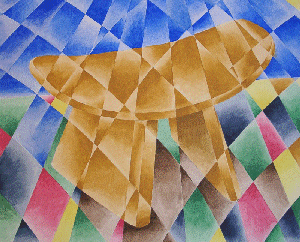
In this 'gap' there is the possibility of seeing this spontaneous awakeness - it is wonderful to observe and it is fundamentally you (it is not just our habits picked up along the way). It is the heart of your mind from which everything you do can be done. In my painting 'Beads Obscure the Thread' I have tried to show this awakeness, shown by the thread, which is so often covered up (obscured) by our thoughts and habits (the beads).

When we see how the thoughts come and go, when we try to meditate, we can follow them from their source of origin and start to get an understanding of why we think and feel the way we do about things. In principle this process reveals the seed of our creativity, our tendency and reason for strengths and weakness etc.
As we grow up we learn to react to things and we learn habits. Sometimes these reactions are helpful sometimes they are very unhelpful. Through meditation we reveal a frame of mind that is a sort of bedrock to our thinking and therefore to our whole world. It is more central to us (wiser) than many of these habits we have (perhaps randomly) picked up.
There is an amazing observation –
'if the mind is not contrived, it is spontaneously blissful, just as water, when not agitated, is by nature transparent and clear'. I often compare the mind in meditation to a jar of muddy water; the more we leave the water without interfering or stirring it, the more the particles of dirt will sink to the bottom, letting the natural clarity of the water shine through. The very nature of the mind is such that if you only leave it in its unaltered and natural state, it will find its true nature, which is bliss and clarity.
The Tibetan Book of Living and Dying, Sogyal Rinpoche, 10th Anniversary Edition p.75
So, the true nature of the mind (when it is not contrived – conceptualising or reacting by habit) is fundamentally happy and content. It is our reaction to things, which if not understood or kept in check, can create and develop unhappiness and confusion. True we are insecure creatures; we want everything to stay the same and the good things to last for ever, but everything changes. Without change atoms could not make bonds which could not make chemicals to make us and our world. Only impermanence can create a universe. This impermanence is a natural cause of a lot of pain and heartache. Meditation reveals something that is unchanging through out all these changes even if at the same time it reveals our very thoughts are all impermanent!
Meditation it is a unique experiment we can do to watch ourselves, to become aware of our thinking and learn and grow, we can come face to face with ourselves. We see a true spirit of what it means to be alive – we observe spirituality.
Shamatha and Vipashyana
There are many different types of meditation and these have slightly different interpretations from culture to culture and place to place. In the Buddhist tradition there seems to be two stages in the meditation process - Shamatha and Vipashyana. The first stage called Shamatha (or calm abiding) is where the mind is left to settle and we are less and less distracted by our thoughts and habits.
In this state we still have thoughts and habits (the 'mud' see the quote above), they form part of the structure of our mind. These habits will be stimulated like a reflex action when circumstances trigger them. Some of these reflexes may be good, some will not be good for us, some will not be good for the way we interact with others - they may be bad habits.
The next stage of meditation, once the mind has settled in Shamatha, is Vipashyana. Vipashana means 'clear seeing' or 'insight'. This deals directly with these fundamental ingrained reflex habits, changing them so that in principle the bad ones don't happen anymore (little by little we remove the 'mud', or a better analogy might be that it evaporates away. Note: as they are only ways of thinking there is actually nothing 'real' or concrete about them). If need be, new habits are developed that benefit oneself and others (I see this as the 'reason' for ceremony and group practices). The Vipashyana process is hard to explain in words, like all learning processes it is very much an experience.
It is rather like the problem of trying to remember when you were young, why you had a particular problem with reading and writing. Now that you can speak and write so easily it all seems so obvious - it is difficult to think back to a fuzzier, less clear state. Once the new mental pattern has been learned (becomes the new habit), it replaces the old ones making it is difficult (or perhaps impossible) to remember the old ones.
Below I have tried to use simple diagrams to outline the Shamatha and Vipashyana meditation process. Here the box represents the mind living in the universe. The lower half represents our potential for thoughts, concepts and perceptions (the shapes) some of which get fixed into our life habits (the shapes in the top half).
It is my own interpretation based on what I have learnt from the two Easter Retreats (2003 and 2004) with Sogyal Rinpoche and in France (2000). Any mistake or misinterpretations are my own.
Shamatha and Vipashyana meditation

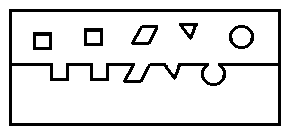
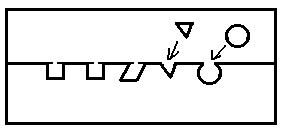
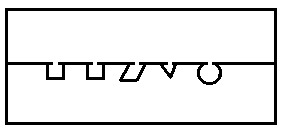
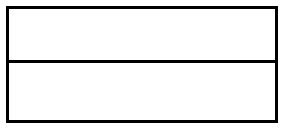
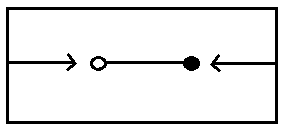
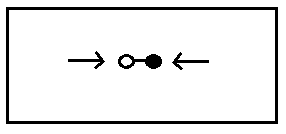
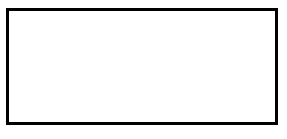
All this is hard to explain and even harder to do and maintain!
Letting thoughts 'drop' through the practice of meditation is a way of simplifying the activity of the mind and I think that it is in this frame of mind that one tends to see things more clearly. I also think meditation helps to drop the 'hang ups' that can occupy the mind and which ultimately can stop you even from starting something.
Appendix II
Here is a list of the various activities and projects undertaken during my NESTA fellowship. Also included is rough outline of key points of each year. See my reports for further details.
Prototypes and inventions
The shake-a-gen (see publications)
Shake-a-gen storage device
Mk1 and Mk2 PIC Moon clocks
24V – 12V converter
AA battery re-activator
Geodesic dome models
Travel lap top power supply
Power point remote control
Large Fullerene LED demonstration
Small table or lap top monitor
Telephone controller (DTMF) device
NESTA Logo gobo (unfinished)
Low power LED flashers & long term results
The X-antenna – a portable antenna for VHF work
Grey line indicator (unfinished)
Accumulations counter
Drawings
NESTA Logo
Various sketches from Leonardo da Vinci's pocket books
Various sketches from H H Dalai Lama trip, France 2000
Various sketches made on-location while filming TV (2000 – 2004)
Maori Mirror Woodcut design (2002)
Paintings (water colours)
Sky, Olive branch and Moon (2001)
Distraction - 15&pi chair (2002)
Beads obscure the thread (2003)
Mirrors on a Thailand Temple (2003)
Theodoras' spiral (2004)
Sculptures
Leonardo da Vinci 'machine'
Trust – Arabic design hand filed from a metal sheet 40 x 15 cm (see June 2003 report)
Trips, courses and travelling
The Path to Enlightenment, H H Dalia Lama, France (200)
Meditation Matters (2001)
Bringing the Mind Home (2002)
Easter Retreat, Sogyal Rinpoche, Hailbury College (2002)
Easter Retreat, Sogyal Rinpoche, Hailbury College (2003)
NESTA Future Lab, Bristol 2002
Art / Science Conference, Oxford 2001
Campaign for drawing day, London 2001
Campaign for Drawing, JPH's RI workshop 2001
Welding course 2002
Each year at a glance
Year 1: 2000 - 2001
This year included starting on a couple of meditation courses and a very memorable 5 day trip to France to see H. H. Dalai Lama who was teaching on 'The Path to Enlightenment'. I also started on a couple of painting ideas, made sketches and designed a NESTA logo. I built a battery reactivator to act as a drop-in centre for people to be able to get another 'life' (!) from their batteries. A number of other inventions and prototypes were built.
Year 2: 2001 - 2002
The highlight this year was a trip to the V & A and the British Library to view (and hold) some of Leonardo da Vinci note books. I made many sketches from these and built a simple Leonardo 'machine' based on a sketch. I used NESTA time to think about wave power (see 'additional thoughts' below) and this lead me to think about a range of electrical generators. A remarkably simple design unfolded and lead to the Shake-a-gen and a storage device to make it more efficient. Other prototypes and inventions were aimed at solving day to day computer problems including a travel supply and a remote for my power point presentations. Built a Moon clock out of basic electrical components. Also completed various sketches and a painting - Sky, Olive Branch and Moon.
Year 3: 2002 - 3003
Started working on a range of new integrated circuit called PIC's. Wanted to pursue the idea of replacing the many electrical components in the Moon clock with a single one of these 'all singing all dancing' PIC chips. The Shake-a-gen became a workshop at my science centre and was published in a book and a science Journal for teachers and students. Went on a 10 day Easter meditation retreat held by Sogyal Rinpoche. Started to develop graphic explanations of meditation through my paintings including; 1) 'Meditation', 2) 'Distraction – š chair' and 3) 'Beads Obscure the Thread'. Made drawings of Maori art and this led to a woodcut mirror design. Worked on a metal sculpture (TRUST) bringing together ideas on maths and humanity via a fabulous Arabic pattern.
Year 4: 2003 - 2004
Designed a really nice simple Moon clock based on my NESTA PIC chip work. This was published in a popular electronics magazine. Other publications include a simple portable VHF 'X-antenna' and 'Voice on a Sunbeam' which came out of NESTA research into an American Engineers (Forest Mims) notebooks. I am asked by Nuffield / Oxford if this article can be used in a new pilot teachers resource pack. Make up a post card as a NESTA publicity card for my work. This was based on one of my paintings made this year – Theodoras' spiral. Attend the Easter retreat again and became branch manager for the local meditation group here in Sussex. I presented some of my work at the NESTA EVENT in January. Fellowship ends with me actively writing, developing prototypes on the technologies that I have explored during the fellowship and (with 4 years of ideas and material) exploring painting and other graphical artistic expressions.
Appendix III - Publications and articles
Voice on a Sunbeam included as part of -
21st Century Science Pilot - Resources (for Teachers)
Nuffield, Oxford and University of York, 2004 Edited by Barry Stone
ISBN 0 19 914920 8
How to Draw a Football, J. P. Hare, published on the SEED (Schlumberger Excellence in Education) web site,
July 2004, soon to be translated into 7 languages. see: http://www.seed.slb.com/en/scictr/watch/fullerenes2/index.htm
The X-antenna - a 'backpack' antenna for portable work on 6m
J. P. Hare, Six News - Journal of the UK six meter group, June 2004, p.38-42
Simple PIC Moon Clock
J. P. Hare, Everyday Practical Electronics, April 2004, p. 254–256
Voice on a Sunbeam
J. P. Hare, IOP press, Journal of Physics Education, May 2004, p.242-246
Demonstrating the wonderful amplifying action of a transistor
J. P. Hare, IOP press, Journal of Physics Education, March 2004, p.128-131
A simple high temperature light bulb thermometer
J. P. Hare, IOP press, Journal of Physics Education, September 2003, p.378-380
The shake-a-gen
J. P. Hare, IOP press, Journal of Physics Education, September 2002, p.436-439
Electrical generator (The shake-a-gen)
The little Book of Experiments, Planet Science, Science Year Publication, Hodder & Stoughton, 2002. ISBN 0 340 87591 7
Theodras' spiral post card – made up to give out to people interested in my NESTA work and my work through The Creative Science Centre.
For a complete listing of JPH's publications see:
http://www.creative-science.org.uk/jphpub.html
Newspaper articles around award time:
Dr Amazing's £48,000 award, The Argus, 30 May, 2000.
Creativity fund gives £2.8m to 'amazing people'
The Daily Telegraph, May 16, 2000.
Hatching plots from a £2.4 million Nesta egg
The Times Higher Educational Supplement, May 12, 2000.
Appendix IV
Feedback and comments on my art work.
Comments on JPH's NESTA artwork by
artist 1
Dear Jonathan,
Thank you so very much for sending me the link to your paintings... which I enjoyed very much... One suggestion, just as an enjoyable meditation is clean of the clutter of thoughts, I would give the images a lot more room on the page to be seen without the distraction of the words around them ... painting is a non-verbal communication and if you give too much "chatter" with them, even if the words about spiritual matters, the paintings themselves are detracted from, and they won't work as well ... note how I have done my site, with a mind to the page colour to kind of set off the paintings, and enough space around them so that they are viewed alone and one at a time, I hope, on the screen.
Having said that, I enjoy your latest works, and would like to view them in the above-mentioned setting, such that I enjoy them even more. Sogyal Rinpoche - what a great book - the Tibetan Book of Living and Dying ... read it with great interest, and it seemed to ring true with my own meager experience. My sister just gave me a book by the Dalai Lama, "How To Practice", and I just began it, every sentence seems to be super- charged with Truth.
I myself am practicing Transcendental Meditation for over 30 years, and in the last 17-18 years also the TM Siddhis programme, both which I feel has helped the quality of my existence as best I can discern on many different levels. This is a life's work, and there is still much, much more to be done. So Jonathan, we are also radio amateurs, which I believe to a kind of metaphysical hobby in itself, in terms of its desire to overcome the bounds of time and space!
Keep up the excellent painting...
My wishes and blessings for your spiritual progress and everything else that you need and will enrich you.
Yours Ron
Comments on JPH's NESTA artwork by artist 2
Dear Jonathan
Well I'm happy you asked for my comments on your wonderful art.
My immediate impression was one of happiness, light and openness. For me art is a spiritual connection; an inspiration from a Divine source that has to filter its way down to us. The cleaner and purer our inner world the more able we are, I feel, to access that place and reproduce something from beyond our normal consciousness.
What I connect with in your work are those qualities I mentioned above. You may find, as I do, that the observer and the artist form a sort of communion, with the work as an intermediary. Different people will, therefore, respond in different ways. This is stating the obvious but for the artist, I think it is important to understand that art reflects human nature and the role of art is to help us gain an insight into ourselves and to the times we live in, but also with something beyond our rational mind. To bring true culture into the world.
I am very much an advocate of the long term school, where art is a lifetime's work in progress, an investigation, a method for perfecting skills.
It is hard to really give feedback from a digital image, as subtleties get smoothed out. I feel your work is well worth taking seriously and if you haven't done so already, perhaps organise and exhibition for yourself. Please invite me! I also feel your work would transfer well into prints, cards etc. I find this easier to suggest to another artist, but to do it for myself is very hard!!! I'm still struggling to organise my own work. It is all in storage at the moment and I have no studio to work in.
There is a strong element of cubism in your approach but also I see the mathematical forms of Islamic art, powerfully represented. I could see you working on a larger scale and in oils, or murals.
I hope this is useful. Working as an artist can be very introverted and self-obsessed. So it has been lovely for me to have this opportunity to communicate with you. There are some lovely artists in Lewes but in general most artists are preoccupied with worldly recognition and success, so they can view you as competition!
warmest wishes.
Constantina
home | diary | whats on | CSC summary | latest news